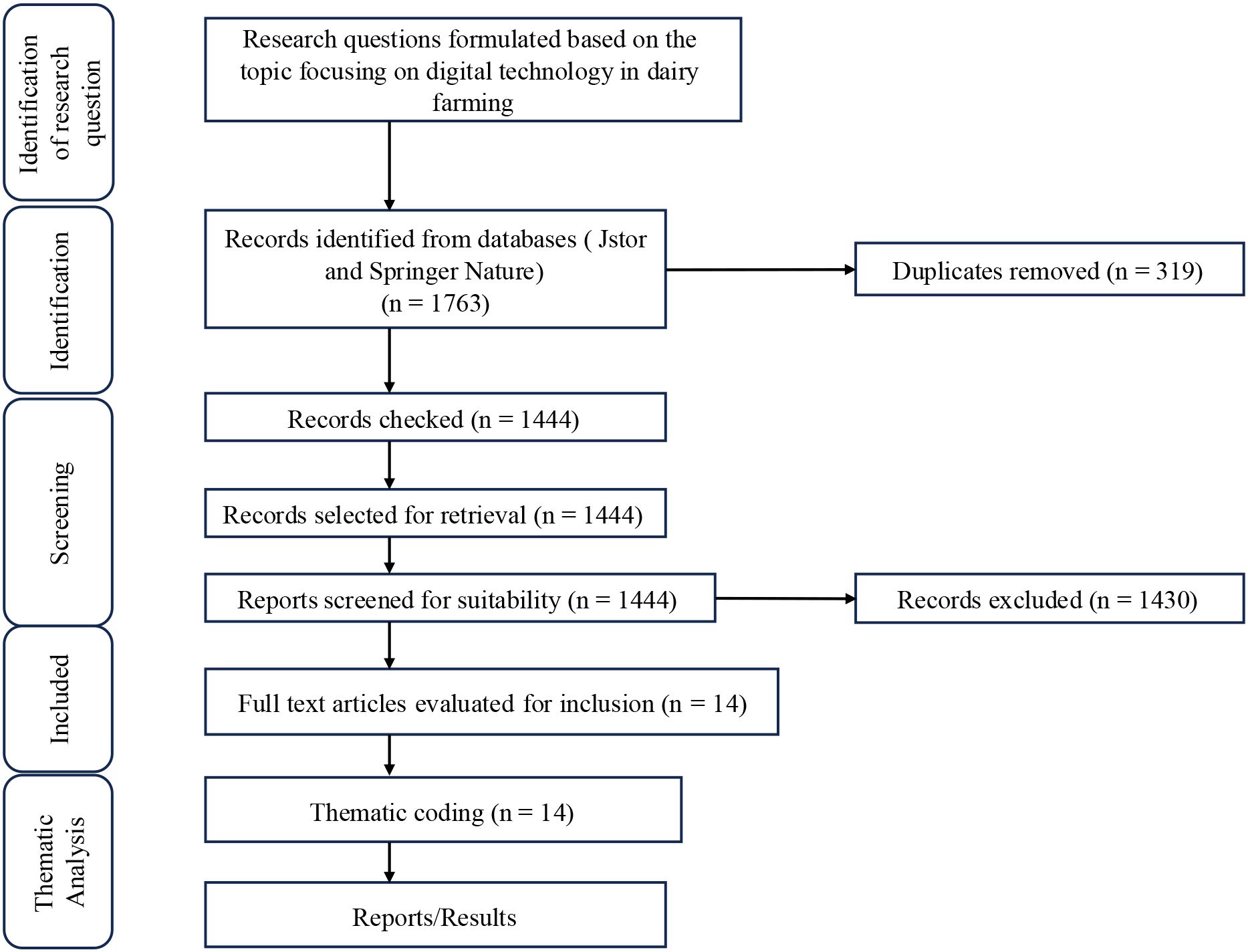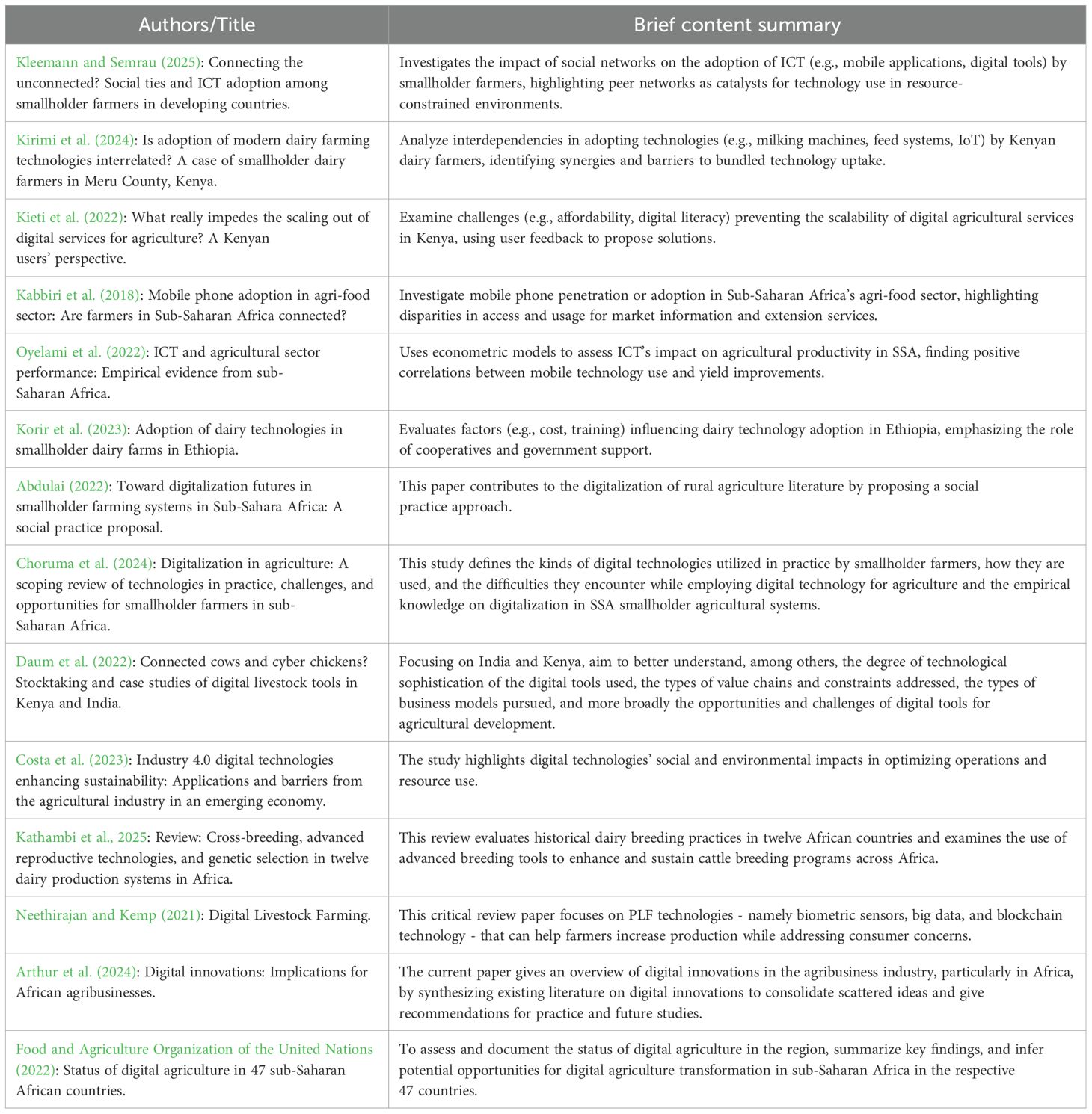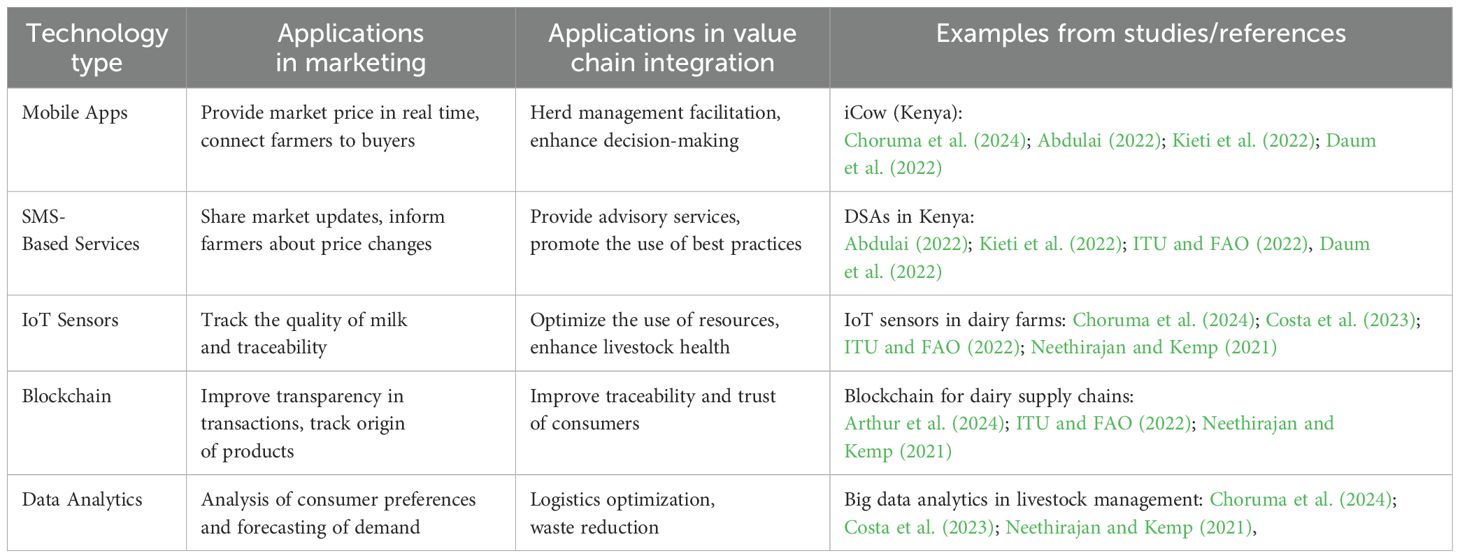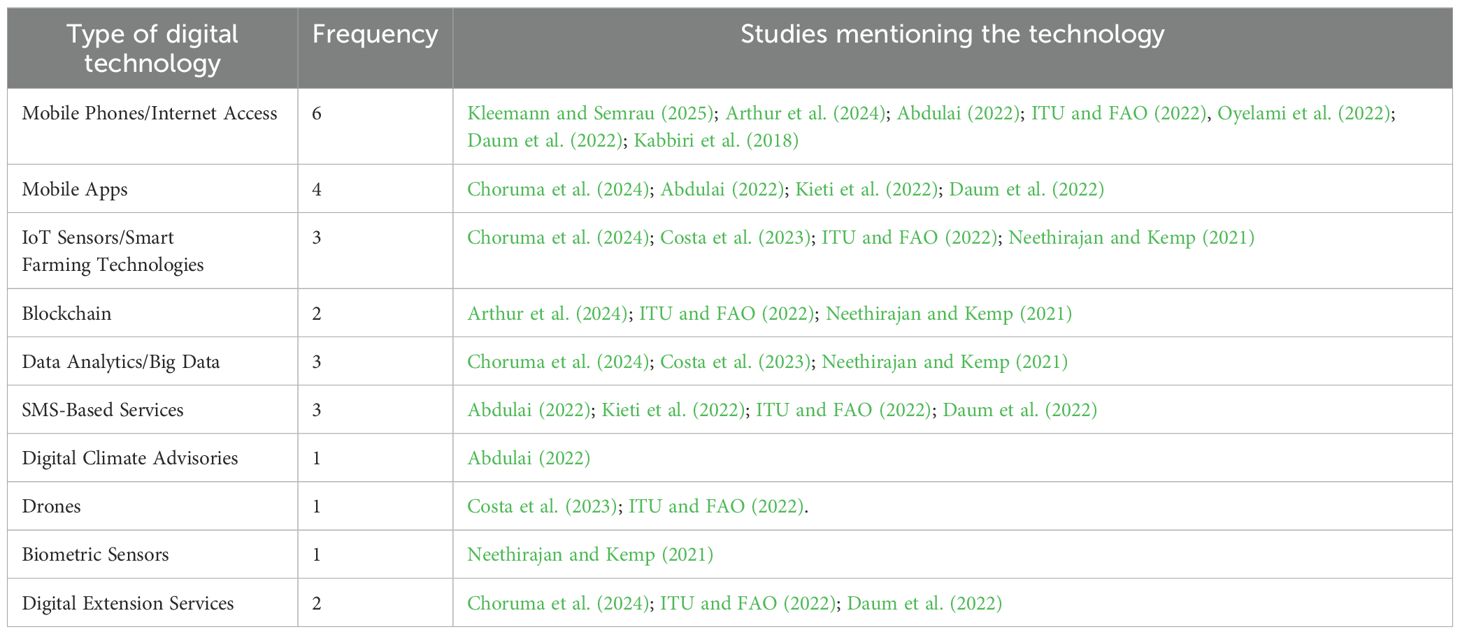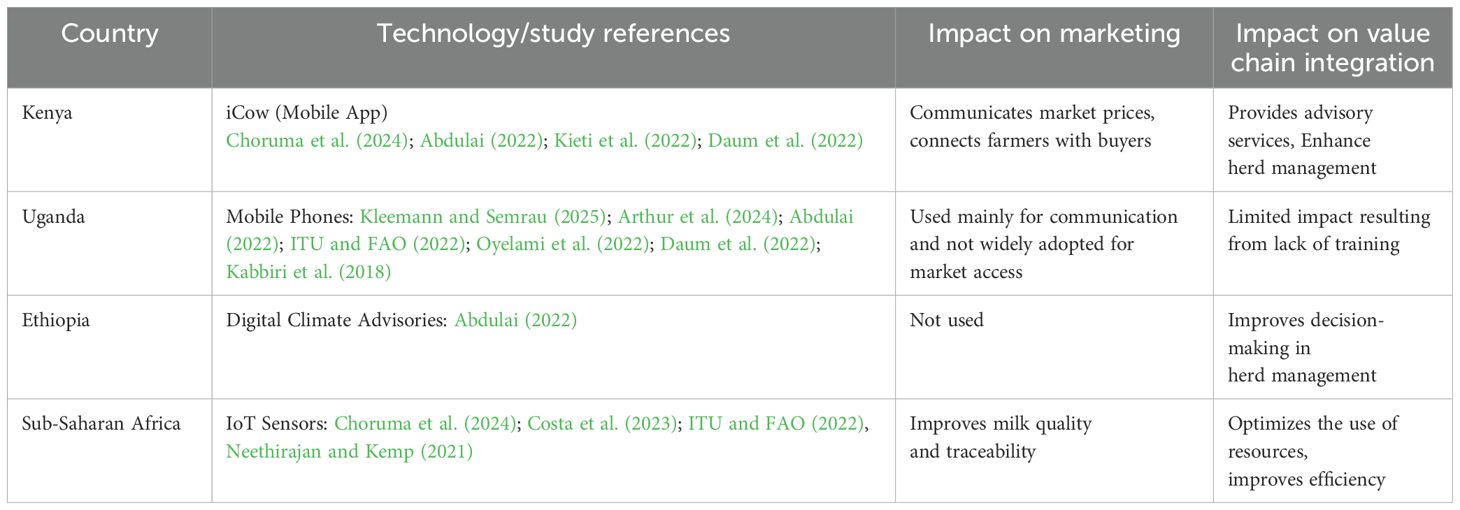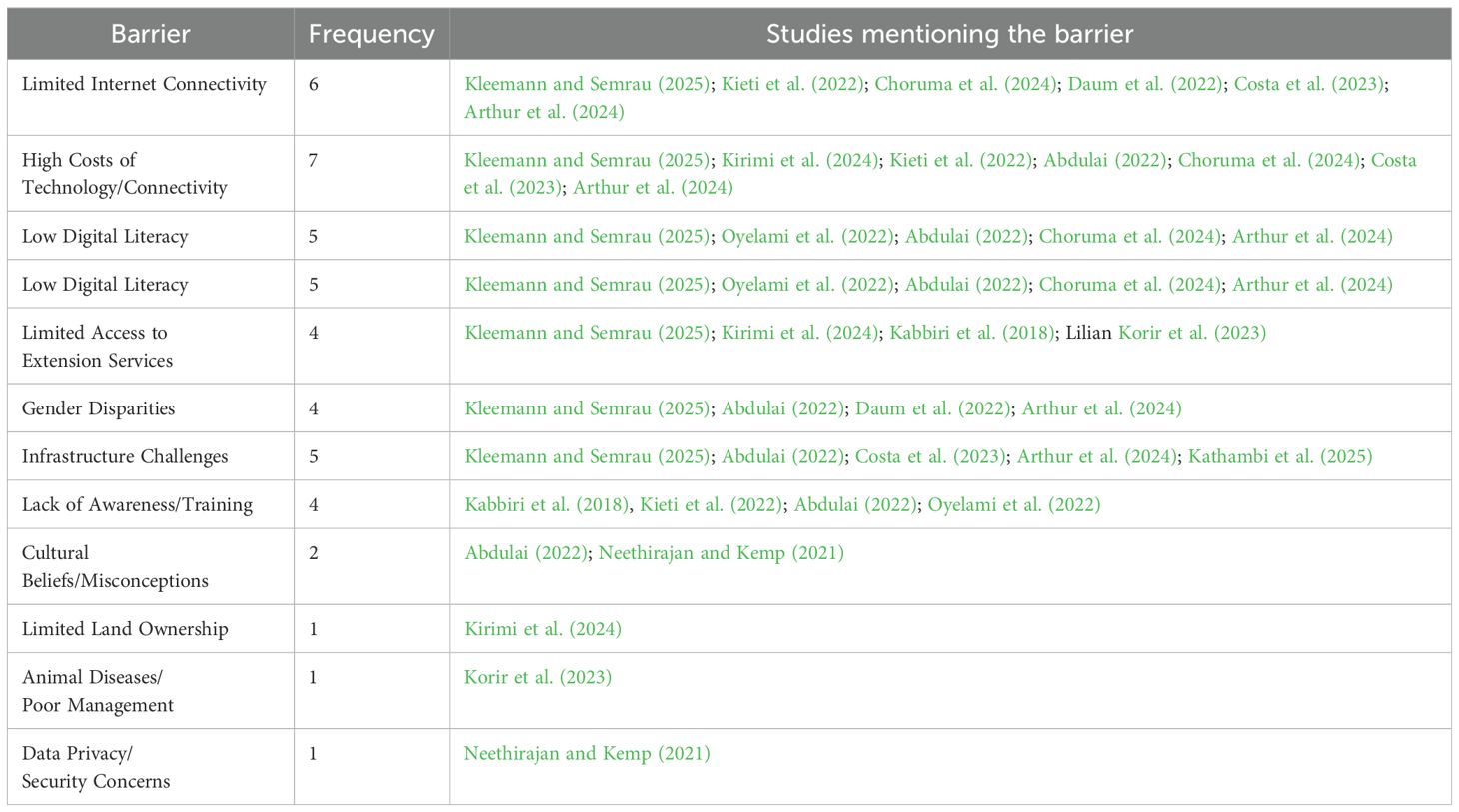- 1Departimento di Agraria, Università Degli Studi di Sassari, Sassari, Italy
- 2Fondazione per la Sostenibilità Digitale (Institute for Digital Sustainability), Roma, Italy
This systematic review examines the role of digital technologies in enhancing marketing and value chain integration in Africa’s dairy sector. Drawing on 14 peer-reviewed studies conducted between 2014 and 2025, the review explores the types of digital tools being adopted, assesses their impact on dairy market dynamics and supply chain coordination, and identifies the structural, economic, and socio-cultural barriers that hinder their broader adoption. The findings reveal that mobile technologies, particularly SMS-based services and applications remain the most widely utilized, offering farmers access to market prices, buyer networks, and advisory services. More advanced tools are being introduced gradually and show promise in improving traceability, milk quality monitoring, resource optimization, and transparency across the value chain. Despite these advances, significant challenges persist. The review identifies limited internet connectivity, high costs of digital devices and services, low levels of digital literacy, and gender disparities as major obstacles, particularly in rural areas. These challenges are exacerbated by inadequate infrastructure and a lack of targeted training and support mechanisms. The review concludes that while digital technologies offer transformative potential for improving efficiency, profitability, and equity in the dairy sector, their success depends on context-specific strategies, inclusive design, and strong multi-stakeholder collaboration. It calls for future research to address regional gaps, particularly in North and Central Africa, and to focus on the long-term sustainability and social dimensions of digital transformation. By addressing these gaps and fostering enabling environments, digital innovation can serve as a catalyst for a more inclusive, productive, and resilient dairy industry across the African continent.
1 Introduction
The dairy sector is a major contributor to Africa agricultural economy, enhancing food security, creating jobs and improving the livelihoods of rural communities. Smallholder farmers contribute about 85 per cent of continent’s dairy production, which is mostly informal and fragmented, with inefficiencies in production, distribution and marketing. These inefficiencies are reinforced by factors such as inadequate infrastructure, insufficient storage options and limited market linkages, which interferes with the competitiveness and development opportunities (ITU and FAO, 2022). The rapid evolution of digital technology is revolutionizing traditional agricultural processes and providing new opportunities to increase efficiency, transparency and value chain integration. The use of digital technology in dairy marketing and value chain management is particularly important in Africa, where reliable information, financial services and access to market opportunities are major challenges to progress. A careful assessment of the impact of digital technology on marketing and value chain integration in the African dairy chain is important to synthesize current research, identify best practices and highlight policy implications for sustainable development in this sector.
Digital transitions in the dairy sector in Africa are being driven by many advanced digital technologies, including mobile technology, e-commerce platforms, artificial intelligence (AI), Internet of Things (IoT), blockchain and big data analytics. Mobile applications and digital payment platforms, such as M-Pesa in East Africa, have improved financial inclusion for dairy farmers by facilitating direct payments from consumers, providing access to credit, and ensuring secure transactions without relying on traditional banking institutions (Owuor, 2021). E-commerce platforms have also revolutionized dairy marketing by facilitating direct interaction between farmers, processors and consumers, eliminating the need for middlemen and improving profit margins for farmers (Kumar et al., 2021). In addition, IoT-enabled technologies such as smart sensors and automated milk monitoring systems have increased production efficiency by providing real-time data on milk quality, storage status and animal health (Marwa et al., 2020). Similarly, blockchain technology has been accepted to improve traceability and verification in the dairy value chain, increasing product safety and consumer confidence (Mavilia and Pisani, 2021). At the same time, these technologies improve an integrated and transparent dairy value chain, allowing stakeholders to optimize decision-making and drive performance across the sector.
Despite the clear benefits of digitalization, the adoption of digital technology in the dairy sector in Africa faces many structural and specific challenges. A significant barrier is the digital divide, as most smallholder farmers do not have access to smartphones, reliable internet connectivity and the necessary digital literacy to effectively use digital technologies. The cost of implementing digital solutions is a challenge for resource-constrained farmers and cooperatives, especially for advanced AI, IoT and blockchain technologies, which hinder the scalability of these innovations. In addition, regulatory constraints, such as the lack of standardized digital rules and inadequate enforcement mechanisms, hinder the widespread use of digital tools in the dairy sector (ITU and FAO, 2022).
To address these challenges, a collaborative strategy involving decision-makers, technology providers, financial institutions and agricultural organizations is needed to foster a digital innovation environment in the dairy sector.
The initial level of analysis of the degree of digitization of the African continent’s dairy supply chains must start with systematic reviews, which are essential to consolidate research results, identify knowledge gaps and formulate policies, but there is a lack of research on the impact of digital technologies on value chain integration and marketing in this sector.
Strategies to improve productivity in dairy production have been the subject of several systematic reviews. Kathambi et al. (2025) analyzed the impact of improved cattle breeds on milk yield in different parts of African countries. They concluded that better veterinary care and nutrition, combined with genetic improvement, significantly increased milk productivity. Similarly, Kumar et al. (2016) conducted a review of disease control in dairy farming, highlighting the importance of vaccination programs and antimicrobial interventions in improving cattle morbidity. While these studies provide important insights into improving the dairy sector, they do not specifically address the role of digital technologies in improving the dairy value chain and marketing.
Another important area of attention in systematic reviews was food safety and quality assurance. Akinyemi et al. (2021) conducted a synthesis of research on milk safety standards in sub-Saharan Africa, revealing notable deficiencies in regulatory enforcement and compliance. The paper highlighted the potential of using digital traceability solutions, including blockchain technology, to improve food safety. A study by (Chandan, 2015) reviewed quality assurance interventions in dairy production, highlighting how mobile-based monitoring systems and digital certification platforms adhere to hygiene standards and foster consumer trust. While these reviews illustrate the importance of digital technologies in food safety, they do not examine their broader applications in marketing and value chain integration.
Systematic reviews of digital technologies in agriculture in Africa have mainly focused on general agricultural activities rather than specifically on the dairy sector. For example (Deichmann et al., 2016), examined the impact of mobile technologies on agricultural value chains and found that mobile money, digital marketplaces and precision agriculture reduce transaction costs and improve market access. However, there was no discussion of dairy in their review. Mavilia and Pisani (2021) also reviewed blockchain applications in African agribusiness and showed its contribution to supply chain transparency, but they did not explore the link between blockchain, AI and big data in dairy production.
A systematic review of policy and institutional frameworks in the dairy sector was conducted. ITU and FAO (2022) assessed dairy regulations in East Africa and found that inconsistent policies and poor enforcement hinder digital adoption. The study advocated the implementation of digital literacy initiatives and the provision of regulatory support for technology-driven innovation. The report highlighted the need for multi-stakeholder collaboration to address technology barriers in African agriculture. However, these assessments lack a comprehensive revision of empirical research on digital tools in dairy value chains.
Systematic analyses have provided considerable insight into the dairy sector in Africa, covering various aspects such as productivity, food safety and policy, but conspicuously absent is an examination of the role of digital technology in integrating marketing and dairy value chains. In addition, there remains a geographical bias towards East Africa, resulting in a gap in the understanding of trends across the continent. In contrast to earlier studies that looked at information and communication technology in African agriculture more broadly (Deichmann et al., 2016) or dairy productivity efforts (Kathambi et al., 2025), this study highlights three novel breakthroughs. a. Sectoral Specificity (resolve a fragmentation in agri-food meta-analyses by focusing only on digitalization in African dairy value chains). b. Marketing-Value Chain Nexus: In contrast to general technology evaluations, we examine how tools change fundamental marketing tasks while incorporating the principles of the SCOR model (Plan-Source-Deliver); c. Power Redistribution Lens: We are the first to analyze stakeholder-level effects, revealing how tools redistribute power, a dimension that has not been covered in previous research.
1.1 Conceptualizing marketing innovation in dairy
Digital transformation is more than just operational efficiency; it fundamentally alters conventional marketing models. According to Kotler’s 4Ps model (Zineldin and Philipson, 2007), digital technologies transform:
Product: IoT/blockchain enable quality-based segmentation (premium “verified safe” milk grades).
Price: Mobile apps facilitate dynamic pricing via real-time market data (e.g., iCow’s notifications).
Place: E-commerce sites facilitate disintermediation since supply chains are shortened (Kumar et al., 2021).
Promotion: SMS/digital advisories enable specific targeting of farmers far away.
Also, Relationship Marketing theory (Grönroos, 2017) explains how platforms like Herdman establish direct farmer-buyer trust, while Digital Consumer Journey models (Lemon and Verhoef, 2016) explain how blockchain traceability builds post-purchase trust (e.g., QR code origin verification). This review seeks to fill this gap by providing an in-depth analysis of digital technologies in dairy marketing and value chain integration in Africa. The specific aim of this study is to synthesize current findings on the impact of digital technologies on dairy value chain integration and marketing throughout Africa, providing a comprehensive and evidence-based understanding which has been achieved through a systematic review of peer-reviewed journal articles, reports from international organizations and conference proceedings.
Specifically, the review will address the following question.
i. What are the predominant digital technologies being adopted in Africa’s dairy sector?
ii. In what ways might digital technologies improve value chain integration and change fundamental marketing activities including segmentation, pricing strategies, value proposition, channel management?
iii. What are the main challenges in adopting digital technology in the dairy sector, and what strategies can be adopted to overcome them.
2 Materials and methods
This review uses a methodological and organized framework to integrate and analyze the current body of literature on the impact of digital technologies on marketing and value chain integration in the dairy sector in Africa.
This study follows the principles of transparency, replicability and methodological rigor in the identification, selection, analysis and synthesis of relevant literature by adopting the Preferred Reporting Items for Systematic Reviews and Meta-Analyses (PRISMA) guidelines (Page et al., 2021). This assessment process followed these five key stages: formulation of research questions, identification of relevant literature, screening and eligibility assessment, data extraction and synthesis, and critical appraisal of the results.
A comprehensive recent (2014 – 2025) literature examination was conducted on the topic, “The impact of digital transition on marketing and value chain integration in Africa’s dairy production”, taking advantage of a systematic search strategy across two prominent academic databases: JSTOR and Springer Nature. The process involved the development of the search strings carefully crafted to guarantee the identification of relevant studies while reducing the incidence of irrelevant results.
Search parameters were developed to identify studies related to digital technologies in dairy production and their impact on marketing efficiency and value chain integration in Africa. Two sets of search terms were used: first, “digital technology or dairy and Africa”, with the purpose of identifying studies that focused on the use of digital technology in dairy production, mainly in the African context; secondly, “marketing efficiency or price chain integration and dairy”, which broadened the parameters to include studies on marketing efficiency and value chain integration in the dairy industry.
The initial searches on the databases yielded the following outcomes: JSTOR, 1,091 results and Springer Nature, 672 results.
To eliminate redundancy, the findings obtained from the two databases were imported to Mendeley Reference Management software (Mendeley, 2025). Using Mendeley’s duplicate detection feature, 319 duplicates were identified and removed, pruning the number of records to a total of 1,444 unique items for further screening.
The remaining datasets were further subjected to a two-step screening process: first, the datasets were evaluated based on their titles and abstracts to determine their alignment with the study’s objectives (datasets not related to digital technologies, dairy, or value chain integration in Africa were excluded); second, 14 articles that specifically focused on the use of digital technologies in the dairy sector in the African context remained for full-text review (Figure 1; Table 1).
The data extraction process was carried out using a standardized coding framework to ensure both consistency and reliability in the analysis of the final selected papers. The main data extracted from the papers encapsulated the objectives of the study, the methodologies used, the exploration of digital technologies, the implications for marketing and value chain integration, the challenges identified and the policy suggestions proposed. The extracted data were carefully organized into thematic categories using a narrative synthesis methodology (Mishra and Mishra, 2023) to ensure recognition of recurring patterns, knowledge gaps and emerging trends. The thematic synthesis process facilitated the classification of digital interventions according to their contributions to market access, supply chain efficiency, economic inclusion and quality assurance. In addition, an independent reviewer assessed inter-rater reliability to reduce bias and ensure the credibility of the findings.
Although this systematic review follows a rigorous approach, several limitations must be acknowledged. The restriction to English-language publications may have resulted in the omission of relevant research published in French, Portuguese or other African languages. Secondly, while efforts were made to include grey literature from reputable organizations, some unpublished or sector-specific publications may be inaccessible, which may limit the breadth of insight into the private sector digitization initiative in the dairy industry in Africa. Third, due to the rapid development of digital technology, new advances may not be well documented in the peer-reviewed literature, requiring supplementary research from industry reports and policy briefs. Despite these obstacles, the analytical approach adopted ensures a comprehensive and evidence-based assessment of the impact of digital technology on the dairy sector in Africa.
3 Results
The types of digital technologies discussed in the selected studies and their applications in marketing and value chain integration, reported in Table 2, highlight their dual roles in marketing and value chain integration. Mobile applications, such as iCow in Kenya, are instrumental in bridging the information gap between producers and markets by offering real-time pricing data and facilitating herd management decisions. SMS-based services, like the DSAs used in Kenya, extend the reach of digital advisory tools to remote areas, supporting knowledge dissemination and the adoption of best practices. Internet of Things (IoT) sensors represent a significant technological advancement in quality assurance and animal health monitoring. Their deployment on dairy farms enhances traceability and enables data-driven resource optimization. Blockchain technology further strengthens trust and transparency across the dairy supply chain by enabling secure, tamper-proof tracking of product origin and transaction histories. Lastly, data analytics play a crucial role in aligning production with market demand, improving logistics, and minimizing losses by leveraging insights into consumer behavior and operational inefficiencies.
The Table 3 summarizes the frequency of digital technologies mentioned across recent studies on agricultural innovation, with a focus on the dairy sector. Mobile phones and internet access appear to be the most frequently cited tools, underscoring their foundational role in enabling connectivity and digital service delivery. Mobile applications also feature prominently, reflecting their increasing use in providing targeted support for farm management and market access.
Emerging technologies such as IoT sensors, data analytics, and blockchain are gaining traction, albeit less frequently mentioned, indicating a gradual integration into more advanced or resource-equipped farming systems. SMS-based services remain relevant due to their accessibility in low-connectivity regions, while specialized tools like drones, biometric sensors, and digital climate advisories are still limited to a few pilot initiatives or niche applications.
Table 4 highlights the research of specific cases where digital technologies have affected marketing and value chain integration. In Kenya, the iCow mobile application demonstrates a well-integrated digital solution, enhancing both market access and farm management through real-time pricing and advisory services. By contrast, in Uganda, while mobile phones are available, their limited use for marketing purposes and the lack of user training hinder their effectiveness in integrating smallholders into value chains. In Ethiopia, digital climate advisories are not leveraged for marketing but have shown potential in supporting herd management decisions, particularly in climate-sensitive production environments. At a broader regional level, the deployment of IoT sensors across Sub-Saharan Africa marks a significant step toward digital transformation. These technologies contribute to improving milk quality, traceability, and operational efficiency, although their adoption may still be constrained by infrastructure and cost. Overall, the table reflects a heterogeneous digital landscape, where the impact of technologies varies significantly depending on the country context, user capacity, and level of integration into the production system.
Table 5 highlights the most frequently cited barriers to the adoption of digital technologies in African agriculture, particularly within the dairy sector. The two most prominent challenges, limited internet connectivity and high costs of technology and connectivity, reflect structural constraints that disproportionately affect rural areas, where digital infrastructure remains underdeveloped. These issues are closely followed by low digital literacy, which hinders farmers’ ability to effectively use digital tools, even when available.
Infrastructure challenges and limited access to extension services further exacerbate the digital divide by restricting the dissemination of knowledge and support needed for technology adoption. Notably, gender disparities are repeatedly mentioned, emphasizing the unequal access to digital resources and training opportunities faced by women in many agricultural communities.
Other less frequently cited, yet still significant, barriers include cultural beliefs, limited land ownership, and concerns about data privacy, issues that can subtly but meaningfully affect technology uptake. The presence of animal health challenges and poor farm management also underscores the need for integrated approaches that combine digital solutions with improved veterinary and advisory services. Table 6 highlights Digital Technologies and Their Impact on Marketing Functions.
Digital technologies go beyond linear value chains by allowing integrated supply networks that follow frameworks such as the SCOR model (Plan, Source, Make, Deliver, Return) and demand-driven logistics. In Africa’s dairy industry, this manifests as follows:
a. Real-time monitoring of milk temperature and quality using IoT sensors reduces spoiling by 25-40% during transportation (Costa et al., 2023). Solar-powered trackers in milk cans sync with mobile applications in Tanzania, alerting cooperatives to deviations, and Blockchain digitizes the SCOR “Source” and “Deliver” stages, generating immutable records from milking to retail (for example, Kenya’s IBM-supported program verifies ethical sourcing).
b. Agility and Responsiveness (Real-time analytics improve the SCOR “Plan” and “Deliver” functions: South Africa’s MilkWise uses AI to predict demand spikes, rerouting deliveries via mobile alerts during disruptions (Oyelami et al., 2022), and Ethiopian cooperatives reduce collection times by 30% using GPS-enabled route optimization).
c. Cold Chain Integrity: Nigeria’s ColdHubs employ demand-driven logistics to adjust storage allocation based on SMS orders, while Uganda’s solar-chilled IoT hubs keep milk at 4°C during power outages, increasing shelf life by 72 hours (Table 2).
d. Demand-Driven Networks: Platforms such as Kenya’s iCow use real-time yield data to synchronize smallholders and processors, lowering waste by 22% and aligning output (SCOR “Make”) with market demands (Kieti et al., 2022).
Digital technologies are altering power dynamics within the dairy business. Farmers have unprecedented agency thanks to mobile-enabled price transparency and direct sales, which minimize reliance on merchants and alleviate fundamental information asymmetry (Abdulai, 2022). Cooperatives employ IoT and blockchain to ensure quality, transitioning from price takers to negotiators. In contrast, processors use predictive analytics to impose downstream control on supply volumes and timing in line with SCOR’s ‘Plan’ principles. Traders suffer from disintermediation but react via digital auction platforms. Critically, cold chain technology (such as IoT-chilled hubs in Uganda) mostly gives compliance power to cooperatives and processors, while smallholders continue to depend on shared infrastructure.
4 Discussion
Digital technologies have become central to transforming Africa’s dairy sector, particularly in improving market access and facilitating value chain integration. One of their most significant contributions lies in enhancing farmers’ access to real-time information on market prices, demand, and buyer networks. For example (Kleemann and Semrau, 2025), demonstrate that the integration of strong social ties and ICT (Information and Communication Technology) use among smallholder farmers improves both agricultural productivity and market access. Their cross-country analysis across 12 African nations highlights how mobile phones and internet connectivity help overcome traditional barriers such as geographic isolation and the absence of intermediaries.
Similarly (Kieti et al., 2022), and (Abdulai, 2022) underscore the transformative potential of mobile apps and SMS-based services in Kenya, which facilitate direct connections between dairy farmers, buyers, and cooperatives. These digital services reduce transaction costs, increase profitability, and enhance transparency by lowering information asymmetry. In addition, platforms like iCow, Herdman, and Farmtree applications are not only provide marketing functions but also offer critical advisory services and support improved herd management (Daum et al., 2022).
Beyond marketing, digital technologies play a vital role in value chain integration. IoT sensors, as illustrated by (Costa et al., 2023), are increasingly used to ensure milk traceability, optimize resource use, and monitor quality throughout production. Blockchain technologies enhance transparency and enable traceability, fostering consumer trust and supporting compliance with global standards (Neethirajan and Kemp, 2021). Complementing these are data analytics tools, which drive predictive modeling, logistical optimization, and waste reduction. Choruma et al. (2024) also highlight the importance of digital extension services in knowledge dissemination and promoting informed decision-making among smallholders.
The socio-economic benefits of digital adoption are evident. Improved market access and productivity have been consistently linked to increased incomes (Choruma et al., 2024; Abdulai, 2022). Moreover, digital tools promote inclusivity by enhancing opportunities for marginalized groups, especially women and youth. Kleemann and Semrau (2025) emphasize that gender-sensitive interventions are necessary to close the digital divide, particularly for female-headed households, who often face systemic barriers to ICT access.
Despite their promise, the adoption of digital technologies in Africa’s dairy sector faces considerable challenges, which can be broadly categorized into infrastructural, economic, and socio-cultural factors. Limited internet connectivity, especially in rural areas, remains a pervasive issue, as noted by (Kieti et al., 2022) (Choruma et al., 2024), and (Oyelami et al., 2022). These connectivity constraints are compounded by poor infrastructure, including inconsistent electricity supply and inadequate road networks (Costa et al., 2023). Public-private partnerships and state-led investments are essential to establish an enabling environment for digital transformation.
Cost is another major barrier. The high price of devices, data plans, and subscriptions significantly limits access for smallholder farmers. Arthur et al. (2024) highlights the difficulty in adopting advanced tools like IoT sensors and blockchain technologies due to a lack of accessible financing. Kleemann and Semrau (2025) also point to the correlation between education, income levels, and ICT adoption, emphasizing the socio-economic disparities that influence digital uptake.
Low levels of digital literacy further constrain the effective use of available technologies. According to (Oyelami et al., 2022) and (Daum et al., 2022), the lack of technical know-how limits the capacity of farmers to fully exploit digital tools. Gender inequalities exacerbate this challenge, with entrenched norms reducing the likelihood of technology adoption among women (Kleemann and Semrau, 2025). Addressing this issue requires inclusive training programs and user-friendly design tailored to diverse needs.
A lack of awareness and trust also inhibits adoption. As shown by (Kabbiri et al., 2018), many Ugandan farmers use mobile phones solely for basic communication, underutilizing their market-related functions. Kirimi et al. (2024) stressed the importance of robust extension services to bridge this information gap and promote digital literacy. Abdulai (2022) adds that cultural beliefs and misconceptions, if unaddressed, can further fuel resistance to innovation.
To facilitate widespread adoption, digital tools must be context-sensitive aligned with local customs, values, and constraints. This means designing inclusive platforms, addressing gender disparities, and offering financial incentives. Policymakers should prioritize training and support programs, while partnerships between governments, private stakeholders, and development organizations can mobilize resources, enhance reach, and drive sustainable transformation across the dairy value chain.
Digital technologies have fundamentally altered marketing roles. IoT sensors and blockchain, under the 4Ps, revolutionize the fundamental product offering by providing verifiable quality traits, allowing for segmentation and premium pricing. Platforms such as iCow restructure Place by eliminating middlemen, whilst real-time data enables Price optimization.
This is consistent with Relationship Marketing principles: direct digital partnerships (such as Farmtree) promote loyalty via transparency and personalized guidance. Crucially, traceability technologies (blockchain/IoT) are transforming the digital consumer experience. Consumers that utilize QR codes to check product origin report increased post-purchase trust, which impacts retention and readiness to pay (Neethirajan and Kemp, 2021).
However, unequal adoption may exclude smallholders from these segmented value propositions. This review builds on previous work by connecting digital tools to marketing theory, exposing how IoT cold-chain tech rebalances power, and mapping demand-driven disruptions that are absent in linear chain models. No previous review or effort has addressed these factors in Africa’s dairy business.
5 Conclusions
This systematic review sets out to examine the convergence of digital transformation and dairy development in Africa by addressing three fundamental questions: (i) what digital technologies are being adopted; (ii) how these technologies impact marketing and value chain integration; and (iii) what barriers hinder their widespread implementation.
The findings reveal a steadily expanding landscape of digital adoption across the African dairy sector. Mobile-based technologies, such as SMS services and applications like iCow, remain the most prevalent, owing to their affordability, accessibility, and user-friendliness. These foundational tools are increasingly supplemented by more advanced innovations, including Internet of Things (IoT) sensors, blockchain systems, big data analytics, and digital extension platforms. While these technologies are not yet ubiquitous, their gradual integration into more technologically equipped environments indicates a broader shift toward digital sophistication.
The review also underscores the transformative potential of these technologies in enhancing both marketing and value chain efficiency. Mobile platforms enable real-time access to price information, reduce reliance on intermediaries, and improve farmers’ bargaining power. Concurrently, IoT and blockchain solutions strengthen traceability, ensure milk quality monitoring, and increase transparency along the supply chain. Collectively, these developments contribute to improved productivity, higher incomes for smallholders, and greater consumer trust both locally and internationally.
Nonetheless, several persistent challenges continue to impede adoption. Chief among them are limited internet connectivity, high costs of devices and data, inadequate digital literacy, and entrenched gender inequalities. These are compounded by infrastructural deficits, particularly in electricity supply and transport networks, which further hinder scalability. Addressing these constraints will require a multi-dimensional strategy involving investments in rural ICT infrastructure, inclusive capacity-building initiatives, gender-responsive policies, and coordinated efforts among governments, private actors, and development partners.
Policies have to make use of marketing theory; subsidies for e-platforms should aim at Place innovation (4Ps) to lower reliance on physical markets. Programs for digital literacy should teach relationship marketing techniques that is, keeping up digital buyer relationships. Traceability tool regulations must standardize Share with consumers a value proposition.
Ultimately, while digital transformation offers immense potential to catalyze growth and inclusivity in Africa’s dairy sector, its success hinges on context-sensitive implementation. Future research should prioritize underrepresented regions, assess long-term impacts, and explore the scalability of emerging technologies. A sustained, evidence-driven, and collaborative approach will be essential to building a resilient, equitable, and digitally empowered dairy value chain across the continent.
Data availability statement
The original contributions presented in the study are included in the article/supplementary material. Further inquiries can be directed to the corresponding author.
Author contributions
CV: Data curation, Formal Analysis, Writing – original draft. SE: Writing – review & editing, Conceptualization, Supervision. GP: Writing – review & editing, Supervision, Conceptualization.
Funding
The author(s) declare that financial support was received for the research and/or publication of this article. Financial support received from PNRR.
Acknowledgments
The authors thank Dipartimento di Agraria, Università Degli Studi di Sassari, Sassari, Italy and Fondazione per la Sostenibilità Digitale (Institute for Digital Sustainability), Roma, Italy for assistance in the preparation of the data used in this study. This study was conducted as part of the first author’s ongoing PhD thesis.
Conflict of interest
The authors declare that the research was conducted in the absence of any commercial or financial relationships that could be construed as a potential conflict of interest.
Generative AI statement
The author(s) declare that no Generative AI was used in the creation of this manuscript.
Publisher’s note
All claims expressed in this article are solely those of the authors and do not necessarily represent those of their affiliated organizations, or those of the publisher, the editors and the reviewers. Any product that may be evaluated in this article, or claim that may be made by its manufacturer, is not guaranteed or endorsed by the publisher.
References
Abdulai A. (2022). Toward digitalization futures in smallholder farming systems in Sub-Sahara Africa: A social practice proposal. Front. Sustain. Food Syst. 6. doi: 10.3389/fsufs.2022.866331
Akinyemi M. O., Ayeni K. I., Ogunremi O. R., Adeleke R. A., Oguntoyinbo F. A., Warth B., et al. (2021). A review of microbes and chemical contaminants in dairy products in sub-Saharan Africa. Compr. Rev. Food Sci. Food Saf. 20, 1188–1220. doi: 10.1111/1541-4337.12712
Arthur K. K., Bannor R. K., Masih J., Oppong-Kyeremeh H., and Appiahene P. (2024). Digital innovations: Implications for African agribusinesses. Smart Agric. Technol. 7, 100407. doi: 10.1016/j.atech.2024.100407
Chandan R. C. (2015). “Dairy processing and quality assurance: an overview,” in Dairy processing and quality assurance (Hoboken, New Jersey: John Wiley & Sons), 1–40.
Choruma D. J., Dirwai T. L., Mutenje M. J., Mustafa M., Chimonyo V. G. P., Jacobs-Mata I., et al. (2024). Digitalisation in agriculture: A scoping review of technologies in practice, challenges, and opportunities for smallholder farmers in sub-saharan africa. J. Agric. Food Res. 18, 101286. doi: 10.1016/j.jafr.2024.101286
Costa F., Frecassetti S., Rossini M., and Portioli-Staudacher A. (2023). Industry 4.0 digital technologies enhancing sustainability: Applications and barriers from the agricultural industry in an emerging economy. J. Cleaner Production 408, 137208. doi: 10.1016/j.jclepro.2023.137208
Daum T., Ravichandran T., Kariuki J., Chagunda M., and Birner R. (2022). Connected cows and cyber chickens? Stocktaking and case studies of digital livestock tools in Kenya and India. Agric. Syst. 196, 103353. doi: 10.1016/j.agsy.2021.103353
Deichmann U., Goyal A., and Mishra D. (2016). Will digital technologies transform agriculture in developing countries? Agric. Economics 47, 21–33. doi: 10.1111/agec.12300
Food and Agriculture Organization of the United Nations (FAO) (2022). Status of digital agriculture in 47 sub-Saharan African countries (Rome: FAO).
Grönroos C. (2017). Relationship marketing and service: An update. J. Global Scholars Marketing Sci. 27, 201–208. doi: 10.1080/21639159.2017.1318666
ITU and Food and Agriculture Organization of the United Nations. (2017). Status of digital agriculture in 47 sub-Saharan African countries. Food & Agriculture Organization of the United Nations.
Kabbiri R., Dora M., Kumar V., Elepu G., and Gellynck X. (2018). Mobile phone adoption in agri-food sector: Are farmers in Sub-Saharan Africa connected? Technological Forecasting Soc. Change 131, 253–261. doi: 10.1016/j.techfore.2017.12.010
Kathambi E. K., Sonstegard T. S., and Larsen P. A. (2025). Review: Cross-breeding, advanced reproductive technologies, and genetic selection in twelve dairy production systems in Africa. Animal: an Int. J. Anim. bioscience 19, 101424. doi: 10.1016/j.animal.2025.101424
Kieti J., Waema T. M., Baumüller H., Ndemo E. B., and Omwansa T. K. (2022). What really impedes the scaling out of digital services for agriculture? A Kenyan users’ perspective. Smart Agric. Technol. 2, 100034. doi: 10.1016/j.atech.2022.100034
Kirimi A. K., Nyarindo W. N., and Gatimbu K. K. (2024). Is adoption of modern dairy farming technologies interrelated? A case of smallholder dairy farmers in Meru county, Kenya. Heliyon 10, e38157. doi: 10.1016/j.heliyon.2024.e38157
Kleemann L. and Semrau F. O. (2025). Connecting the unconnected? Social ties and ICT adoption among smallholder farmers in developing countries. Technological Forecasting Soc. Change 213, 123985. doi: 10.1016/j.techfore.2025.123985
Korir L., Manning L., Moore H. L., Lindahl J. F., Gemechu G., Mihret A., et al. (2023). Adoption of dairy technologies in smallholder dairy farms in Ethiopia. Front. Sustain. Food Syst. 7. doi: 10.3389/fsufs.2023.1070349
Kumar A., Mishra A. K., and Joshi P. K. (2021). Digital technologies for improving dairy value chains in developing economies. Agric. Syst. 190, 103094. doi: 10.1016/j.agsy.2021.103094
Kumar A., Thapa G., Joshi P. K., and Roy D. (2016). Adoption of food safety measures among Nepalese milk producers: Do smallholders benefit? IFPRI Discussion Paper 1556, 1–52.
Lemon K. N. and Verhoef P. C. (2016). Understanding customer experience throughout the customer journey. J. marketing 80, 69–96. doi: 10.1509/jm.15.0420
Marwa M. E., Mburu J., Oburu R. E. J., Mwai O., and Kahumbu S. (2020). Impact of ICT-based extension services on dairy production and household welfare: The case of iCow service in Kenya. J. Agric. Sci. 12, 141–153. doi: 10.5539/jas.v12n3p141
Mavilia R. and Pisani R. (2021). Blockchain for agricultural sector: The case of South Africa. Afr. J. Science Technology Innovation Dev. 14, 845–851. doi: 10.1080/20421338.2021.1908660
Mendeley (2025). Mendeley reference manager [Software]. Available online at: https://www.mendeley.com/reference-management/reference-manager (Accessed March 17, 2025).
Mishra V. and Mishra M. P. (2023). “PRISMA for review of management literature – method, merits, and limitations – an academic review,” in Advancing methodologies of conducting literature review in management domain (Review of management literature, vol. 2). Eds. Rana S., Singh J., and Kathuria S. (Emerald Publishing Limited, Leeds), 125–136. doi: 10.1108/S2754-586520230000002007
Neethirajan S. and Kemp B. (2021). Digital livestock farming. Sensing and bio-sensing research. Sens. Biosens. Res. 32, 100408. doi: 10.1016/j.sbsr.2021.100408
Owuor G. (2021). Filling the niche—A synthesis of financial inclusion among smallholder farmers in africa, the case for Kenya. Modern Economy 12, 1864–1882. doi: 10.4236/me.2021.1212097
Oyelami L. O., Sofoluwe N. A., and Ajeigbe O. M. (2022). ICT and agricultural sector performance: Empirical evidence from sub-Saharan Africa. Future Business J. 8, 18. doi: 10.1186/s43093-022-00130-y
Page M. J., McKenzie J. E., Bossuyt P. M., Boutron I., Hoffmann T. C., Mulrow C. D., et al. (2021). The PRISMA 2020 statement: An updated guideline for reporting systematic reviews. BMJ 372, n71. doi: 10.1136/bmj.n71
Keywords: digital transformation (DT), digital tools, systematic review, marketing integration, dairy value chain
Citation: Vuvor CM, Epifani S and Pulina G (2025) Exploring opportunities in Africa’s dairy production: digital transition as a catalyst for marketing innovation and value chain synergies – a systematic review laying foundations for future research. Front. Anim. Sci. 6:1632532. doi: 10.3389/fanim.2025.1632532
Received: 21 May 2025; Accepted: 28 June 2025;
Published: 16 July 2025.
Edited by:
Idowu Oladele, Global Center on Adaptation, NetherlandsReviewed by:
Giovanni Buonaiuto, University of Bologna, ItalySyahrul Deen Ahmad Rosli, MARA University of Technology, Malaysia
Copyright © 2025 Vuvor, Epifani and Pulina. This is an open-access article distributed under the terms of the Creative Commons Attribution License (CC BY). The use, distribution or reproduction in other forums is permitted, provided the original author(s) and the copyright owner(s) are credited and that the original publication in this journal is cited, in accordance with accepted academic practice. No use, distribution or reproduction is permitted which does not comply with these terms.
*Correspondence: Courage Maccarthy Vuvor, Yy52dXZvckBzdHVkZW50aS51bmlzcy5pdA==
†ORCID: Courage Maccarthy Vuvor, orcid.org/0009-0009-6328-5924
Giuseppe Pulina, orcid.org/0000-0001-5579-0677
 Courage Maccarthy Vuvor
Courage Maccarthy Vuvor Stefano Epifani2
Stefano Epifani2 Giuseppe Pulina
Giuseppe Pulina